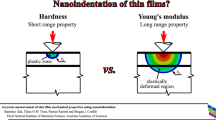Abstract.
The present paper is devoted to the analysis of mechanical and electrical behaviors observed on particulate polymer granular materials. The constituting particles obtained these physical properties by coating the polymer spherical substrate with a conducting polymer: polypyrrole (PPy) which confers electrical conducting properties to the particle, while preserving its mechanical properties. Particle contacts dominate the behavior of the granular media and, consequently, size, morphology, roughness and plasticity of the particles play a crucial role in this behavior. Scanning electron microscope (SEM) and atomic force microscope (AFM) were used to study the surface state and the contact area between neighbors. An experimental set up, based on the measurement of the displacement of contacting particles subjected to a normal force and of the variation of the electrical resistance of the packing, allowed the study of both the mechanical and electrical behaviors of the particle system. The experimental results took into account the plastic deformation under varying loading and unloading conditions; they were consistent with theories of contact mechanics, thus validating the existing models.
Similar content being viewed by others
References
Troadec, J.P.: Thèse d’Etat, Université de Rennes I, France (1983)
Giraud, G.: Thèse d’Etat, Université d’Aix-Marseille I, France (1980)
Bonamy, D.: Thèse de 3éme cycle, Université de Paris XI, France (2001)
Bideau, D.: Thèse d’Etat. Université de Rennes I, France, 1983
Artz, E.: ‘‘The influence of an increasing particle coordination on the densification of spherical powders.’’ Acta Met. 30, 1883 (1982)
Fischmeister, H.F., Artz, E., Olsson, L.R.: ‘‘Particle deformation and sliding during compression of spherical powders: a study by quantitative metallurgy.’’ Powder Met. 4, 179 (1978)
Wilkinson, D.S., Ashby, M.F.: ‘‘Pressure sintering by power law creep.’’ Acta Met. 23, 1277 (1975)
Vu-Quoc, L., Zhang, X., Lesburg, L.: ‘‘Normal and tangential force-displacement relations for frictional elastoplastic contact of spheres.’’ Int. J. Solids Struct. 38, 6455 (2001)
Vu-Quoc, L., Zhang, X.: ‘‘An elastoplastic contact force-displacement model in the normal direction: displacement-driven version.’’ Proc. Roy. Soc. London, Series A 455, 4013 (1999)
Zhang, X., Vu-Quoc, L.: ‘‘A method to extract the mechanical properties of particles in collision based on a new elastoplastic normal force-displacement model.’’ Mech. Mat. 34(12), 779 (2002)
Vu-Quoc, L., Zhang, X., Lesburg, L.: ‘‘A normal force-displacement model for contacting spheres accounting for plastic deformation: force-driven formulation.’’ ASME J. Appl. Mech. 67(2), 237 (2000)
Vu-Quoc, L., Zhang, X., Walton, O.R.: ‘‘A 3-D discrete element method for dry granular flows of ellipsoidal particles.’’ Appl. Mech. Eng. 187(3–4), 483 (2000)
Plantard, G., Papini, M.: ‘‘Radiative and electrical properties of granular materials: application to mixtures of insulating and conducting polymers.’’ J. Quant. Spectrosc. Rad. Transfer 74(3), 329 (2002)
Plantard, G., Papini, M.: ‘‘Analysis of the radiative properties of insulating and conducting granular polymers and their mixtures.’’ Powder Technol. 128(2–3), 287 (2002)
Plantard, G.: Ph.D. thesis, Université d’Aix-Marseille I, France (2002)
Vernitskaya, T.V., Efimov, O.N.: ‘‘Polypyrrole: a conducting polymer; its synthesis, properties and applications.’’ Russian Chem. Rev. 66(5), 443 (1997)
Planche, M.F.: Ph.D. thesis, Université de Grenoble I, France (1992)
Lascelles, S.F., Armes, S.P.: ‘‘Synthesis and characterization of micrometre-sized, polypyrrole-coated polystyrene latexes.’’ J. Mater. Chem. 7(8), 1339 (1997)
Chaudhri, M.M., Huctchings, I.M., Makin, P.L.: ‘‘Plastic compression of spheres.’’ Philos. Mag. A 48(4), 493 (1984)
Timothy, S.P., Pearson, J.M., Huctchings, I.M.: ‘‘The contact pressure distribution during plastic compression of lead spheres.’’ Int. J. Mech. Sci. 29(10–11), 713 (1987)
Kim, K.S., McMeeking, R.M., Johnson, K.L.: ‘‘Adhesion, slip, cohesive zones and energy fluxes for elastic spheres in contact.’’ J. Mech. Phys. Solids. 46(2), 243 (1998)
Storakers, B.: ‘‘Local contact behavior of viscoplastic particles.’’ IUTAM, Symp. Mech. of Granular and Porous Materials, 1997, pp. 173
Mesarovic, S.Dj., Fleck, N.A.: ‘‘Frictionless indentation of dissimilar elastic-plastic spheres.’’ Int. J. Solids Struct. 37, 7071 (2000)
Johnson, K.L: ‘‘Contact mechanics.’’ Cambridge Univ. Press, Cambridge (1985)
Fischmeister, H.F., Artz, E.: ‘‘Densification of powders by particle deformation.’’ Powder Met. 2-, 82 (1983)
Thornton, C., Ning, Z.: ‘‘A theoretical model for the stick/bounce behavior of adhesive, elastic-plastic spheres.’’ Powder Technol. 99, 154 (1998)
Holm, R.: ‘‘Electric contacts.’’ Springer Verlag, Berlin, 4th edition (2000)
Boyer, L., Noel, S., Houze, F.: ‘‘Determination of the effective contact radius between a conducting sphere and a thin metallic film.’’ J. Phys. D: Appl. Phys. 21, 495 (1988)
Féchant, L.: ‘‘Le contact électrique: Phénomènes Physiques et Matériaux.’’ 2, Hermès, Paris (1996)
Mindlin, R.D., Deresiewicz, H.: ‘‘Elastic spheres in contact under varying oblique forces.’’ ASME, J. Appl. Mechanics 20, 327 (1953)
Dobry, R., Petrakis, E., Seridi, A.: ‘‘General model for contact law between two rough spheres.’’ ASCE, J. Engineering Mechanics 117(6), 1365 (1991)
Brunner, J., Hammerschmid, H.: ‘‘Uber die elektr. Leitfähigkeit gepresster graphit-pulver. ‘‘Zeitschrift für Elektrochemie 40(2), 60 (1934)
Henninger, F.P.: ‘‘Widerstandsmessungen an bor und siliciumcarbid.’’ Annalen der Physik 5. Folge, 28(3), 245 (1937)
Glicksmann, R., Morehouse, C.K.: ‘‘Resistivity study of various Leclanché cathode materials.’’ J. Electrochem. Soc. 103(3), 149 (1956)
Euler, K.J.: ‘‘The conductivity of compressed powders. A review,’’ J. Powder Sources 3, 117 (1978)
Euler, K.J.: ‘‘Elektrische Leitfähigkeit von pulvern unter druck.’’ Bull, Schweiz. ETV 63, 1498 (1972)
Euler, K.J.: ‘‘Elektrische Leitfähigkeit von braunsteinpulver unter druck,’’ Mettaloberflache 28(1), 15 (1974)
Euler, K.J.: ‘‘Leitfähigkeit von mischkomprimaten.’’ RTZ(B), 28(2), 45 (1976)
Author information
Authors and Affiliations
Corresponding author
Rights and permissions
About this article
Cite this article
Plantard, G., Papini, M. Mechanical and electrical behaviors of polymer particles. Experimental study of the contact area between two particles. Experimental validation of a numerical model. Granular Matter 7, 1–12 (2005). https://doi.org/10.1007/s10035-004-0194-6
Received:
Published:
Issue Date:
DOI: https://doi.org/10.1007/s10035-004-0194-6




